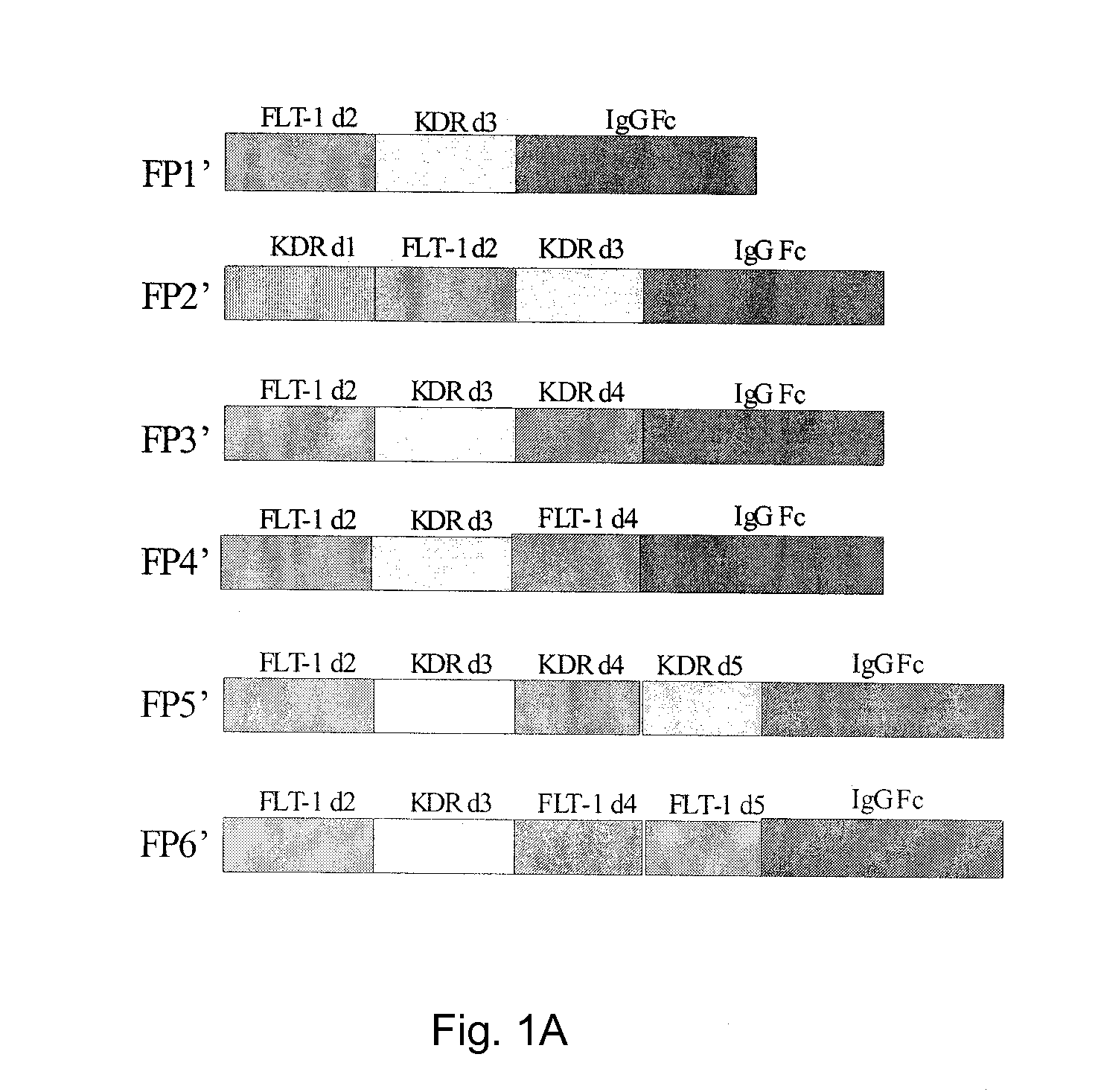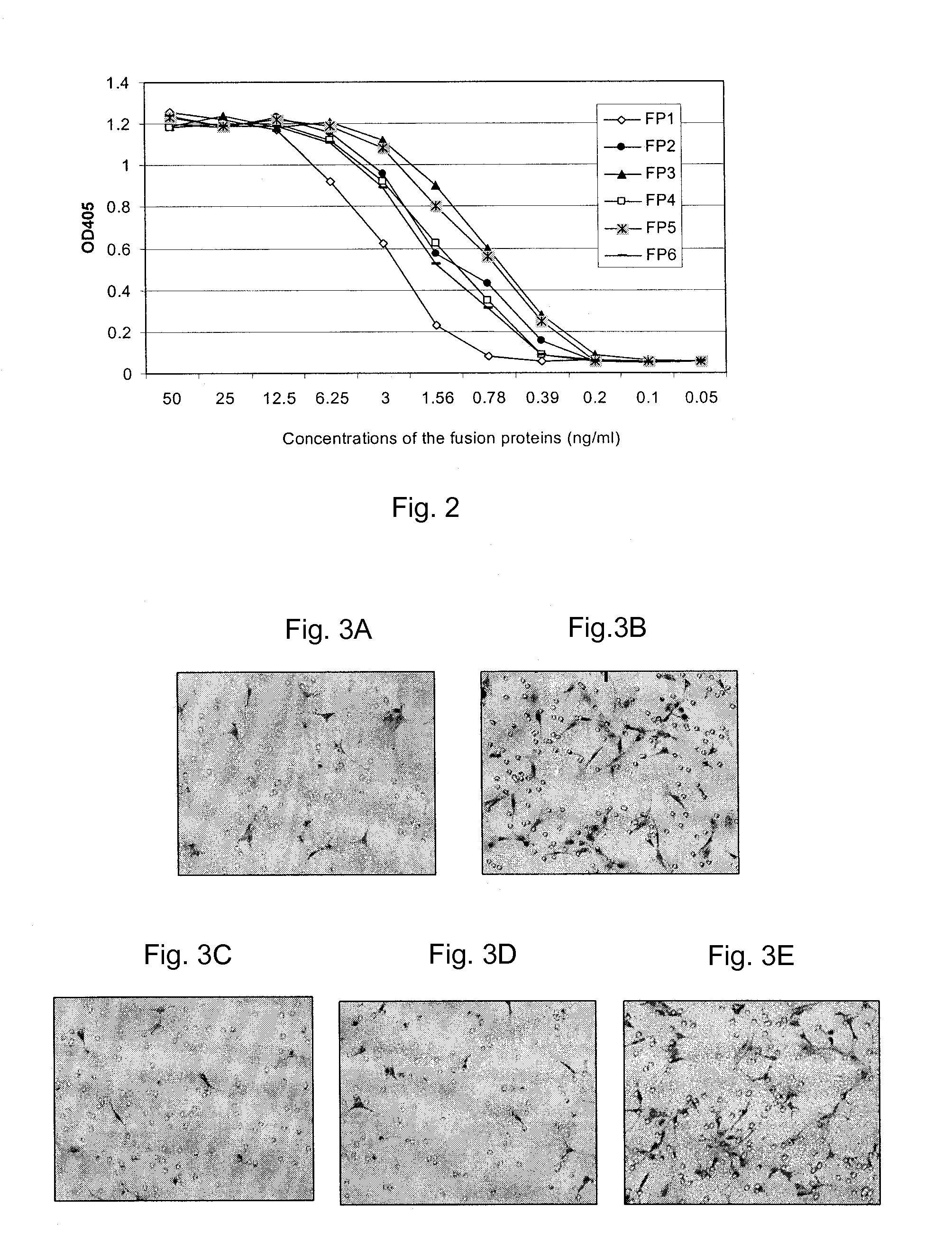Inhibition of neovascularization with a soluble chimeric protein comprising VEGF FLT-1 and KDR domains
a chimeric protein and soluble technology, applied in the field of soluble chimeric fusion proteins, can solve the problems of scarring of the retina, hyperopsia and visual loss, and often leakage of the tissue wall, and achieve the effects of reducing the mean choroidal neovascularization leakage, reducing the mean foveal retinal thickness, and improving visual acuity
- Summary
- Abstract
- Description
- Claims
- Application Information
AI Technical Summary
Benefits of technology
Problems solved by technology
Method used
Image
Examples
example 1
Clone Selection in CHO DUXB11 Cells
[0173]Standard molecular biology techniques were used to insert the FP3′ coding sequence into the pCMVi expression vector (unpublished results; Kanghong Biotechnology, Ltd.) at a multiple cloning site downstream of the CMV promoter. CHO DUXB11 cells were transfected with the recombinant pCMVi expression vector using an Amaxa Nucleofector™ II Transfector. The transfected CHO DUXB11 cells were grown in IMEM (SAFC Biosciences) containing 1% HT supplement (Gibco) and 10% FBS (SAFC Biosciences), and colonies were screened and selected from the transfected pools based on recombinant protein expression using a standard immunoassay which captures and detects human Fc. More than 3000 colonies were selected for high recombinant protein expression and amplified in the presence of methotrexate (MTX; Sigma) using a stepwise increase in MTX concentration with subsequent culture steps to select for clones that produced the most recombinant fusion protein. A serie...
example 2
Expression of Recombinant Fusion Protein in CHO Cells
[0175]A frozen vial containing cells of a characterized production clone was taken from a cell bank and cultured in serum free medium (Sigma) containing MTX. Cells were cultured at 37° C. in a 5% CO2 atmosphere using a Form a Scientific incubator and the culture was expanded for about 2 weeks using a sequence of T-flasks (Falcon), and shaker flasks (Bellco) prior to inoculating a 5 L Celligen plus bioreactor (New Brunswick Scientific). Cells were maintained in the exponential growth phase throughout the expansion process. The cells were cultured in suspension for about 5 days in a 5 L bioreactor until the viable cell density reached 2.5×106 cells / ml. Then they were transferred to a 30 L stainless steel bioreactor (New Brunswick Scientific) at a density of 5×106 cells / ml and cultured in fed-batch mode for about 15 days.
[0176]In the 30 L bioreactor, the temperature was maintained at 37° C. and dissolved oxygen was controlled at 40% ...
example 3
Fusion Protein Purification
[0177]The fusion protein production culture was harvested from the 30 L stainless steel bioreactor after fed-batch fermentation, clarified by depth filtration or centrifugation, and sterile filtered using a 0.2 um filter.
[0178]The fusion protein was initially captured by affinity chromatography using a protein A resin, with high specificity for the Fc portion of the fusion protein. After loading the protein A resin, the protein was washed with a large volume of equilibrating buffer to remove any unbound contaminating protein. The fusion protein was eluted from the resin with a pH 3.5 buffer. The fusion protein fractions were pooled, followed by a validated low pH virus inactivation process.
[0179]After low pH incubation, the captured fusion protein pool was further purified by cation exchange chromatography to remove the majority of impurities. An isocratic or gradient concentration of sodium chloride was used to elute the protein of interest. The fraction ...
PUM
| Property | Measurement | Unit |
|---|---|---|
| temperature | aaaaa | aaaaa |
| temperature | aaaaa | aaaaa |
| pore size | aaaaa | aaaaa |
Abstract
Description
Claims
Application Information
 Login to View More
Login to View More - R&D
- Intellectual Property
- Life Sciences
- Materials
- Tech Scout
- Unparalleled Data Quality
- Higher Quality Content
- 60% Fewer Hallucinations
Browse by: Latest US Patents, China's latest patents, Technical Efficacy Thesaurus, Application Domain, Technology Topic, Popular Technical Reports.
© 2025 PatSnap. All rights reserved.Legal|Privacy policy|Modern Slavery Act Transparency Statement|Sitemap|About US| Contact US: help@patsnap.com



